Bishop's Vestments
The bishop’s liturgical vestments differ from those of the priest and the deacon by their number, the high quality of the materials and by the brilliance of their various adornments, in order to bring out the superiority and brilliance of the bishop’s dignity.
While performing the services, bishops first put on the four vestments: a sticharion, an epitrachelion (stole, which is common to all church ranks), a zone (belt-like cincture) and cuffs (epimanika, which are common to all bishop’s and priest’s ranks).
Together with this, bishops use also other three special vestments: an omophorion, a sakkos (saccos) and an epigonation (palitsa).
The sakkos resembles sticharion, but is shorter, is a garment like a short tunic with half-sleeves, which the bishop wears it over the sticharion, after he puts on the epitrachelion, the zone and the cuffs.
The sakkos is made of linen, wool, silk or velvet and its color can be white, purple or yellow. This vestment is done up, on its two parts, with twelve bells.
The omophorion is a vestment proper only to bishops, being worn on the shoulders, around the neck. It is one of the oldest bishop’s vestments. We have a large omophorion and a small one. The large one is worn and used only at the beginning of the Liturgy, till the Apostle’s lecture, when is replaced by the small one. The large omophorion is as well put at ordination and other Mysteries as church consecrations, exaltations of saints, ordinations a.s.o. Also the bishops use to wear the following distinct signs: miter, nabedrennik, engolpion, pectoral cross, staff (crosier), dikiri and trikiri and the eagle.
-
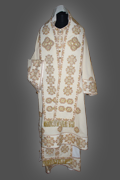
A51
Bishop’s vestment embroidered with floral motifs and crosses...
-
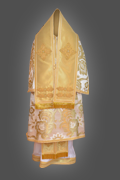
A95
Fabric made by hand with silk and metallic insertions. Accesories such...
-
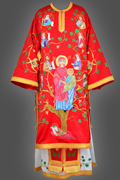
A17
Vestment set with special embroidery.The structure displays Jesus...
-
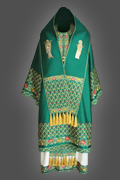
A86
light vestment with simple but elegant cyprus floral...
-
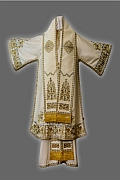
A119
This bishop set is inspired of old embroideries used during the...
-

A18
Bishop garments set with romanian ornamental style - "...
-

A62
...
-

A16
Bishop vestment with embroidery representing saints. price: $...

































